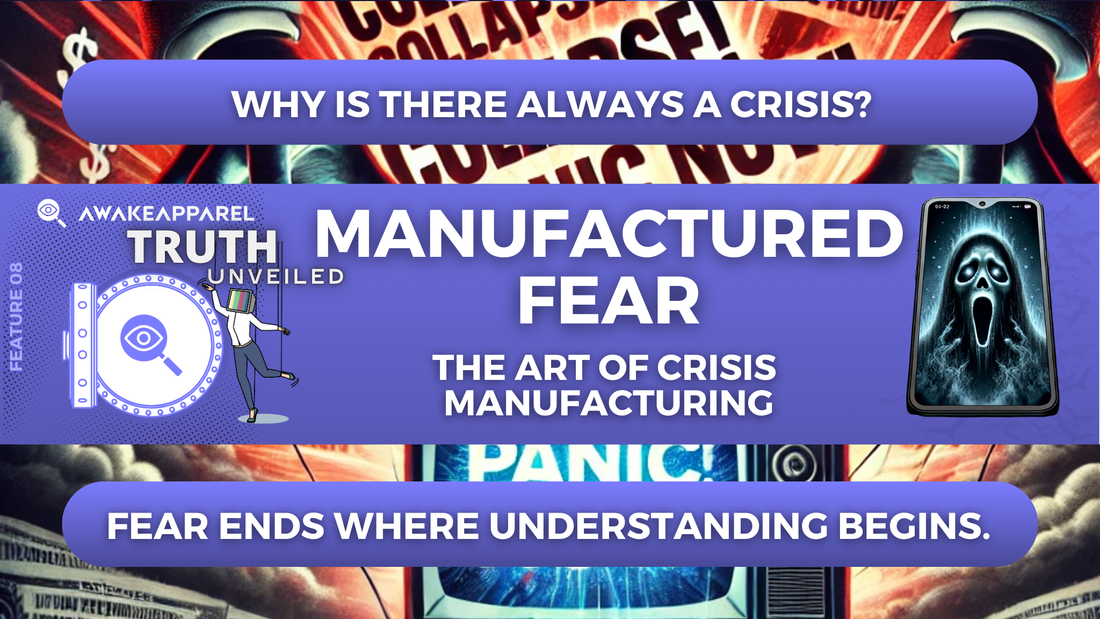
🔥 SPREAD THE TRUTH – Tap to Share!

Why does the world jump from one crisis to the next—like clockwork?
From pandemics to financial crashes, one thing never changes: the fear that grips society.
But what if these crises aren’t just reported?
What if they’re manufactured?
Fear isn’t just an emotion—it’s a currency. It sells narratives. Pushes agendas. Tightens control. When people are afraid, they stop thinking critically. They comply. They obey. They surrender freedoms.
This is how the system works. And once you see it, you can’t unsee it.
🔥 THE PSYCHOLOGY OF FEAR: WHY IT WORKS
Fear hijacks your brain, shutting down rational thought.
When we’re scared, we look for protection. From governments. Corporations. “Trusted experts.”
Fear narrows focus. It makes people hyper-receptive to whatever solution is dangled in front of them—whether it’s war, surveillance, censorship, or giving up personal freedoms in the name of “safety.”
This is how entire societies are controlled.
And if you think this is just a conspiracy theory… let’s break it down.
📖 THE FEAR PLAYBOOK: HOW CRISES ARE ENGINEERED
Step 1: Identify a Vulnerability
A successful fear campaign targets something personal and universal—public health, financial stability, safety, global threats.
If people feel personally at risk, they’re easier to manipulate.
Step 2: Amplify the Threat
Once the vulnerability is found, the media turns the fear dial to max.
🚨 Alarmist headlines.
📢 “Expert warnings.”
📊 24/7 news cycles.
📱 Censorship of alternative viewpoints.
Fear becomes inescapable.
Step 3: Propose “Solutions” That Expand Control
The “solutions” to these crises always require giving up something—whether it’s freedom, privacy, or autonomy.
It’s the same cycle every time.
1️⃣ The “Forever War” Strategy
Endless wars abroad are justified by vague threats:
🧨 WMDs
🛡️ Terrorism
🇺🇸 “Spreading democracy”
The real winners?
🏆 Defense contractors making billions off war.
The losers?
💀 Soldiers and civilians who actually fight and suffer.
![]()
![]()
![]()
![]()
![]()
2️⃣ Economic Fear-Mongering: The 2008 Financial Crisis
Remember “Too Big to Fail”?
💰 Banks got bailed out.
🏠 Millions lost their homes and savings.
📈 Stock market soared—making the rich even richer.
![]()
![]()
![]()
![]()
![]()
Fear of collapse justified mass wealth transfer—from the people to the financial elite.
3️⃣ The Health Crisis Cycle
Public health emergencies always lead to:
💊 Record profits for pharmaceutical giants.
🧾 Unprecedented government power.
🚫 Censorship of dissenting voices.
![]()
![]()
![]()
![]()
![]()
And when the crisis ends?
The emergency powers never fully go away.
📰 THE MEDIA’S ROLE IN FEAR MANIPULATION
The media isn’t just reporting on crises—they’re manufacturing them.
🔥 “Unprecedented”
⚠️ “Dangerous new threat”
🚨 “Global emergency”
![]()
![]()
![]()
![]()
![]()
Ever notice how fear-driven news cycles never cover recovery or positive outcomes?
That’s because fear keeps you engaged.
🛑 Fear = Clicks
📢 Clicks = Ad Revenue
💰 Ad Revenue = Media Power
Social media supercharges this effect, drowning out independent thinking.
The result? A population too distracted and terrified to see the game being played.
🏆 WHO WINS & WHO LOSES?
🚀 The Winners:
• Defense contractors cashing in on war.
• Pharmaceutical giants raking in billions from health fears.
• Politicians passing sweeping control measures under the guise of “safety.”
💀 The Losers:
• Everyday citizens drowning in stress, fear, and loss of freedom.
See the pattern yet?
🧠 HOW FEAR DESTROYS CRITICAL THINKING
Fear shuts down rational debate.
• If you question the narrative, you’re labeled “dangerous.”
• If you ask for proof, you’re silenced.
• If you push back, you’re censored, banned, or fired.
![]()
![]()
![]()
![]()
![]()
Society becomes reactionary, not thoughtful.
But here’s the truth:
👉 Fear only works if we allow it to control us.
🔥 HOW TO BREAK FREE FROM FEAR MANIPULATION
✅ Recognize the Patterns – Ask: Who benefits from this crisis?
✅ Turn Off the Fear Machine – Limit exposure to fear-driven media.
✅ Question the “Solutions” – Does it fix the issue—or just expand control?
✅ Stay Grounded – Fear is contagious, but so is critical thinking.
💡 FINAL THOUGHT: EMPOWERMENT OVER FEAR
Fear is a weapon—but only if you let it control you.
Once you see how fear is engineered, it loses its grip.
🚨 The real pandemic? Manufactured panic.
💡 The real cure? Independent thought.
👉 Share this article. Spread the truth.
Because when fear loses its power, we all win.

Fear-driven narratives are designed to control—not empower. Independent journalism exists to expose these tactics and provide clarity. Your support helps us stay free and focused on truth, not fear. Every donation helps reclaim the narrative—thank you for standing with us.













